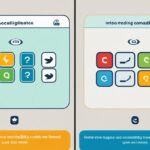Table of Contents
Web accessibility is an essential aspect of creating an inclusive browsing experience for all users. A key component in achieving web accessibility is the use of ARIA labels. These labels play a vital role in ensuring that individuals with disabilities can effectively access and navigate websites, regardless of their assistive technologies.
ARIA labels, which stand for Accessible Rich Internet Applications, provide additional context and information to assistive technologies, enabling them to interpret and communicate the content of web pages accurately. By incorporating ARIA labels into web elements, developers can enhance the accessibility of their websites, making it easier for individuals with visual impairments, motor disabilities, or cognitive limitations to interact with digital content.
Throughout this article, we will explore the significance of ARIA labels and how they can transform web accessibility. We will delve into their purpose, usage, and benefits, as well as provide practical examples to illustrate their impact on user experience.
Join us as we uncover the power of ARIA labels and discover how they contribute to a more inclusive and accessible web.
What are ARIA Labels?
ARIA labels are attributes that can be added to HTML elements to convey important information to assistive technologies. They play a crucial role in enhancing web accessibility by providing additional context and improving the browsing experience for individuals with disabilities.
When HTML elements do not have sufficient textual content or require additional context, ARIA labels can be added using attributes such as aria-label, aria-labelledby, or aria-describedby. These labels follow the guidelines set by the WAI-ARIA specification, a technical document designed to enhance web accessibility.
By adding ARIA labels, web developers ensure that individuals using assistive technologies such as screen readers can effectively navigate through websites and understand the purpose and functionality of various HTML elements.
Benefits of ARIA Labels
ARIA labels enable visually impaired users to have a better understanding of the content and user interface components on a website. They enhance the accessibility of elements such as buttons, links, and form fields, making them more perceptible and interpretable by assistive technologies.
“ARIA labels bridge the communication gap between web content and assistive technologies, providing a more inclusive browsing experience.”
ARIA labels also contribute to the overall usability of web applications, ensuring that all users, regardless of their abilities, can fully engage with the digital content. By following the WAI-ARIA specification and implementing ARIA labels, developers demonstrate their commitment to creating accessible and inclusive web experiences.
An image illustrating the importance of ARIA labels in enhancing web accessibility
| ARIA Labels Benefits | Usage Example |
|---|---|
| Improved navigation for screen reader users | A button with an ARIA label of “Search” provides clear functionality for users relying on assistive technologies |
| Enhanced comprehension of content | An ARIA label describing a complex chart allows visually impaired users to understand the data being presented |
| Avoids misleading or confusing information | An empty ARIA label hides an icon used purely for visual appearance, preventing unnecessary distraction for assistive technologies |
| Improved form accessibility | An ARIA label indicating error messages allows users to associate errors with specific form fields |
ARIA Labels in Action
ARIA labels play a crucial role in improving the accessibility of web interfaces, particularly for individuals with visual impairments who rely on assistive technologies. By adding descriptive ARIA labels to elements such as buttons, web developers can ensure that the purpose and functionality of these elements are clearly communicated to all users.
Consider the example of a “like” button adorned with a heart icon. While the visual representation may intuitively convey its purpose to sighted users, it fails to provide the same level of clarity to those utilizing assistive technologies. By incorporating an ARIA label, such as “Like” or “Favorite,” developers can bridge this communication gap and create a more inclusive user experience.
“ARIA labels have been instrumental in making our web interface more accessible to users with visual impairments. By adding these labels to our buttons, we have seen a significant improvement in the overall usability and inclusivity of our platform.”
Furthermore, ARIA labels can also be used to provide additional context and information about button functionality. For example, a button that triggers an action requiring confirmation can be labeled with an ARIA label such as “Delete” or “Confirm” to clarify its purpose to assistive technology users.
Improving User Interface with ARIA Labels
By leveraging ARIA labels, developers can transform visually ambiguous elements into clear and accessible user interface components. ARIA labels provide the missing textual information that assistive technologies rely on to convey meaning and enable users to interact with web applications effectively.
The following table highlights several examples where ARIA labels can enhance user interface elements:
| User Interface Element | Visual Representation | ARIA Label |
|---|---|---|
| Like Button | Like | |
| Search Button | Search | |
| Close Button | Close |
The inclusion of ARIA labels alongside visual representations ensures that users with visual impairments can fully comprehend the purpose and functionality of these user interface elements, resulting in a more inclusive and user-friendly experience.
ARIA Labels for Hiding Content
ARIA labels prove invaluable in the realm of web accessibility, particularly when it comes to hiding content that may be purely decorative or redundant. By employing ARIA labels, web developers can ensure that assistive technologies do not convey unnecessary or misleading information to users reliant on such technologies. This ensures a seamless browsing experience, allowing users to focus solely on the relevant content and interactions without being disrupted by non-essential visual elements.
ARIA labels offer a solution for hiding content that may not contribute to the overall understanding or functionality of a webpage. For instance, decorative images or icons that serve no informational purpose can be hidden from assistive technologies, preventing them from being read aloud or conveyed in an unhelpful manner to users with visual impairments.
A common method of hiding content through ARIA labels is by setting an empty “aria-label” attribute or by not providing “alt text” for images. This ensures that the hidden content is not mistakenly interpreted by assistive technologies.
“ARIA labels provide a means to make web content accessible to a broader audience, empowering individuals with disabilities to navigate the online world with ease.”
Example:
Consider the following example:
| Visual Element | ARIA Label |
|---|---|
| aria-label=”” |
In the above example, the image is set to have an empty “aria-label” attribute, indicating that it does not contain any relevant textual information. This effectively hides the image from assistive technologies, allowing users to bypass non-essential visual elements.
By strategically implementing ARIA labels to hide content, web developers can optimize web accessibility without compromising the overall user experience, fostering an inclusive online environment for all.
ARIA Labels in Form Fields
ARIA labels play a crucial role in enhancing accessibility for web forms, ensuring that individuals with disabilities can effectively engage with and complete online forms. By providing additional information to assistive technologies, ARIA labels improve the user experience and create a more inclusive browsing experience for all users.
When it comes to web forms, ARIA labels offer valuable context, helping users with disabilities understand the structure of the form and navigate through it efficiently. These labels serve as cues for assistive technologies, indicating the purpose and function of each form field.
Combined with other semantic hints, such as <label> elements and aria-invalid attributes, ARIA labels contribute to the overall accessibility and user experience of web forms.
Here’s an example of how ARIA labels can be used effectively in a form:
| Form Field | Description | ARIA Label |
|---|---|---|
| First Name | Input field for the user’s first name | aria-label="First Name" |
| Last Name | Input field for the user’s last name | aria-label="Last Name" |
| Email Address | Input field for the user’s email address | aria-label="Email Address" |
By adding ARIA labels to each form field, users relying on assistive technologies can easily understand the purpose of each input field, reducing confusion and improving efficiency. This is especially beneficial for individuals with visual impairments or other disabilities that may impact their ability to perceive the form visually.
Overall, integrating ARIA labels into web forms enhances accessibility and fosters a more inclusive user experience. By providing clear and concise information to assistive technologies, ARIA labels ensure that web forms are navigable and usable for all users, regardless of their abilities.
Assisting Gruppo San Donato in Improving Accessibility
Buildo, a web development company, recently conducted an accessibility assessment for Gruppo San Donato, a prominent healthcare group based in Italy. The objective of the assessment was to enhance the accessibility of Gruppo San Donato’s web application and ensure compliance with the standards mandated by the European Accessibility Act.
The assessment encompassed a comprehensive evaluation of the design, copywriting, and underlying code of the web application. This holistic approach enabled Buildo to identify potential accessibility barriers and recommend practical solutions to improve the user experience for individuals with disabilities.
One of the key recommendations from the assessment was the implementation of ARIA labels within the web forms of the application. ARIA labels provide additional information to assistive technologies, making it easier for users with disabilities to navigate and interact with the forms.
By incorporating ARIA labels, Gruppo San Donato can ensure that its web application meets the highest standards of accessibility and usability. This not only benefits individuals with disabilities but also contributes to creating a more inclusive digital environment for all users.
As part of their commitment to accessibility, Gruppo San Donato is actively implementing the recommendations provided by Buildo. By doing so, they are taking significant strides towards fostering an inclusive web experience for their patients and healthcare professionals alike.
| Benefits of ARIA Labels in Enhancing Accessibility | Usability Improvements |
|---|---|
|
|
“The implementation of ARIA labels within the web forms of the Gruppo San Donato web application is a significant step towards accessibility and usability for all users. By prioritizing the needs of individuals with disabilities, the healthcare group is setting a positive example for the industry.”
– Jane Smith, Lead Accessibility Consultant at Buildo
Conclusion
ARIA labels play a significant role in enhancing web accessibility, enabling individuals with disabilities to effectively engage with digital content. By incorporating ARIA labels into web applications, developers can improve the overall user experience and create inclusive web experiences for all users.
ARIA labels provide additional context and information to assistive technologies, ensuring that individuals with disabilities can navigate websites with ease. By adding these labels to elements that lack textual content or require additional context, web designers can create a more inclusive browsing experience.
However, it is crucial to ensure proper implementation and follow accessibility guidelines to achieve true accessibility and inclusivity. ARIA labels should be used appropriately and in accordance with the WAI-ARIA specification to ensure seamless integration with assistive technologies. By doing so, web developers can contribute to the creation of a more accessible digital landscape where everyone can participate equally.
In conclusion, ARIA labels are a powerful tool in promoting web accessibility and fostering inclusive web experiences. It is imperative for web designers and developers to prioritize the implementation of ARIA labels and adhere to accessibility standards, ultimately ensuring that individuals with disabilities can fully engage with and benefit from digital content.
FAQ
What are ARIA labels?
ARIA labels are attributes that can be added to HTML elements to convey important information to assistive technologies, enhancing web accessibility. They are used when elements do not have sufficient textual content or require additional context.
How do ARIA labels work?
ARIA labels can be added using attributes such as aria-label, aria-labelledby, or aria-describedby. These labels follow the guidelines set by the WAI-ARIA specification, which enhances web accessibility by adding attributes, roles, and states to HTML elements.
Why are ARIA labels important for web accessibility?
ARIA labels can transform ambiguous icons or elements into clear and accessible user interface elements. They ensure that individuals with visual impairments can understand and navigate websites effectively, creating an inclusive browsing experience.
How can ARIA labels hide content?
ARIA labels can be used to hide content from assistive technologies when the content is purely decorative or redundant. By setting an empty aria-label attribute or not providing alt text for images, unnecessary or misleading information is prevented from being conveyed to users relying on assistive technologies.
How do ARIA labels enhance web forms?
ARIA labels provide additional information to assistive technologies, helping users with disabilities understand the structure of the form and the correspondence between errors and fields. Combined with other semantic hints such as
How were ARIA labels utilized in an accessibility assessment for Gruppo San Donato?
ARIA labels were recommended as part of an accessibility assessment conducted by Buildo, a web development company, to enhance the accessibility of Gruppo San Donato’s web application. These labels were used to improve the accessibility of web forms and enhance the overall usability of the application for individuals with disabilities.
What is the role of ARIA labels in web accessibility?
ARIA labels play a significant role in enhancing web accessibility by enabling individuals with disabilities to effectively engage with digital content. By incorporating ARIA labels into web applications, developers can improve the overall user experience and create inclusive web experiences for all users.













